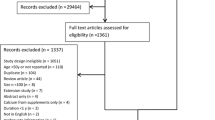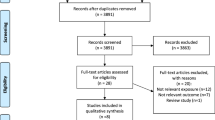Abstract
Objective:
We have reported that a lifestyle intervention with mothers improved calcium intake and physical activity in both mothers and their children. In this study, we aimed to describe the strategies and approaches used by these mothers to improve their children's calcium intake and physical activity.
Design:
A qualitative study using semistructured interviews.
Setting:
Population-based convenience sample.
Subjects:
A subsample of 39 mothers were taken from a population-based random sample of 354 mothers who had participated in the original osteoporosis-prevention trial.
Results:
Mothers described specific dietary changes they made to increase their children's calcium intake. They also described strategies for improving calcium intake and physical activity such as raising awareness of the importance of calcium; ensuring calcium-rich foods were accessible; assessing their children's likes and dislikes and working within these; role modelling; information provision; taking a balanced approach to attempting behaviour change; and encouraging activities that they could do with their children. Mothers emphasized the general importance of a balanced diet and lifestyle, rather than just focussing on lifestyle factors specific to osteoporosis prevention.
Conclusion:
Even without specific guidance, mothers are adept at developing strategies to apply to changing lifestyle behaviours in their children and identifying barriers to change. These results provide information, which could be incorporated into future interventions for lifestyle change in children and also provide further support for considering parent-focused approaches to this problem.
This is a preview of subscription content, access via your institution
Access options
Subscribe to this journal
Receive 12 print issues and online access
$259.00 per year
only $21.58 per issue
Buy this article
- Purchase on Springer Link
- Instant access to full article PDF
Prices may be subject to local taxes which are calculated during checkout
Similar content being viewed by others
References
Bandura A (1994). Self-efficacy. In: Ramachaudran VS (ed) Encyclopedia of Human Behavior. Academic Press: New York.
Bandura A (1986). Social Foundations of Thought and Action. Prentice-Hall: Englewood Cliffs, NJ.
Biddle SJ, Gorely T, Stensel DJ (2004). Health-enhancing physical activity and sedentary behaviour in children and adolescents. J Sports Sci 22, 679–701.
Birch LL, Davison KK (2001). Family environmental factors influencing the developing behavioral controls of food intake and childhood overweight. Pediatr Clin North Am 48, 893–907.
Blalock SJ, DeVellis RF, Giorgino KB, DeVellis BM, Gold DT, Dooley MA et al. (1996). Osteoporosis prevention in premenopausal women: using a stage model approach to examine the predictors of behavior. Health Psychol 15, 84–93.
Charmaz K (2002). Qualitative Interviewing and Grounded Theory Analysis. In: Gubrium J, Holstein J (eds). Handbook of Interview Research: Context and Method. Sage: Thousand Oaks CA.
Clark DO, Nothwehr F (1999). Exercise self-efficacy and its correlates among socioeconomically disadvantaged older adults. Health Educ Behav 26, 535–546.
Cooley H, Jones G (2001). A population-based study of fracture incidence in southern Tasmania: lifetime fracture risk and evidence for geographic variations within the same country. Osteoporos Int 12, 124–130.
Davison KK, Cutting TM, Birch LL (2003). Parents’ activity-related parenting practices predict girls’ physical activity. Med Sci Sports Exerc 35, 1589–1595.
Finnern HW, Sykes DP (2003). The hospital cost of vertebral fractures in the EU: estimates using national datasets. Osteoporos Int 14, 429–436.
Fisher JO, Mitchell DC, Smiciklas-Wright H, Mannino ML, Birch LL (2004). Meeting calcium recommendations during middle childhood reflects mother-daughter beverage choices and predicts bone mineral status. Am J Clin Nutr 79, 698–706.
French SA, Story M, Fulkerson JA, Himes JH, Hannan P, Neumark-Sztainer D et al. (2005). Increasing weight-bearing physical activity and calcium-rich foods to promote bone mass gains among 9–11 year old girls: outcomes of the Cal-Girls Study. Int J Behav Nutr Phys Act 2, 8.
Gillis AJ (1993). Determinants of a health-promoting lifestyle: an integrative review. J Adv Nurs 18, 345–353.
Golan M, Crow S (2004). Targeting parents exclusively in the treatment of childhood obesity: long-term results. Obes Res 12, 357–361.
Goulding A, Cannan R, Williams SM, Gold EJ, Taylor RW, Lewis-Barned NJ (1998). Bone mineral density in girls with forearm fractures. J Bone Miner Res 13, 143–148.
Goulding A, Jones IE, Taylor RW, Williams SM, Manning PJ (2001). Bone mineral density and body composition in boys with distal forearm fractures: a dual-energy X-ray absorptiometry Study. J Pediatr 139, 509–515.
Grbich C (1999). Qualitative Research in Health: an Introduction. Allen and Unwin: Sydney.
Hansen EC (2006). Successful Qualitative Health Research: a Practical Introduction. Allen and Unwin: St Leonards NSW.
Johnell O, Kanis JA (2004). An estimate of the worldwide prevalence, mortality and disability associated with hip fracture. Osteoporos Int 15, 897–902.
Jones G (2006). Relevance of peak bone mass to osteoporosis and fracture risk in later life. In: Lane N, Sambrook P (eds) Osteoporosis and the Osteoporosis of Rheumatic Diseases. Mosby: New York.
Jones G, Nguyen T, Sambrook PN, Kelly PJ, Gilbert C, Eisman JA (1994). Symptomatic fracture incidence in elderly men and women: the Dubbo Osteoporosis Epidemiology Study (DOES). Osteoporos Int 4, 277–282.
Ma D, Jones G (2003). The association between bone mineral density, metacarpal morphometry, and upper limb fractures in children: a population-based case-control study. J Clin Endocrinol Metab 88, 1486–1491.
Marvasti AB (2004). Qualitative Research in Sociology. Sage Publications: London.
McKinley MC, Lowis C, Robson PJ, Wallace JM, Morrissey M, Moran A et al. (2005). It's good to talk: children's views on food and nutrition. Eur J Clin Nutr 59, 542–551.
Moore LL, Lombardi DA, White MJ, Campbell JL, Oliveria SA, Ellison RC (1991). Influence of parents’ physical activity levels on activity levels of young children. J Pediatr 118, 215–219.
Neumark-Sztainer D, Story M, Perry C, Casey MA (1999). Factors influencing food choices of adolescents: findings from focus-group discussions with adolescents. J Am Diet Assoc 99, 929–937.
O’Dea JA (2003). Why do kids eat healthful food? Perceived benefits of and barriers to healthful eating and physical activity among children and adolescents. J Am Diet Assoc 103, 497–501.
Patton MQ (1999). Enhancing the quality and credibility of qualitative analysis. Health Serv Res 34, 1189–1208.
Piaseu N, Schepp K, Belza B (2002). Causal analysis of exercise and calcium intake behaviors for osteoporosis prevention among young women in Thailand. Health Care Women Int 23, 364–376.
Pope C, Mays N (1995). Researching the parts other methods cannot reach: An introduction to qualitative methods in health and health services research. Br Med J 311, 42–45.
Rice PL, Ezzy D (1999). Qualitative Research Methods: A Health Focus. Oxford University Press: Melbourne.
Ritenbaugh C, DeBar L, Aickin M, Elmer PJ, Elliott D, Orwoll E (2003). The effects of a lifestyle intervention for teen girls on bonemineral density. J Bone Miner Res 18, S33.
Sale JEM, Lohfeld LH, Brazil K (2002). Revisiting the quantitative-qualitative debate: implications for mixed-methods research. Quality Quantity 36, 43–53.
Sallis JF, Prochaska JJ, Taylor WC (2000). A review of correlates of physical activity of children and adolescents. Med Sci Sports Exerc 32, 963–975.
Stark LJ, Hommel KA, Mackner LM, Janicke DM, Davis AM, Pfefferkorn M et al. (2005a). Randomized trial comparing two methods of increasing dietary calcium intake in children with inflammatory bowel disease. J Pediatr Gastroenterol Nutr 40, 501–507.
Stark LJ, Janicke DM, McGrath AM, Mackner LM, Hommel KA, Lovell D (2005b). Prevention of osteoporosis: a randomized clinical trial to increase calcium intake in children with juvenile rheumatoid arthritis. J Pediatr Psychol 30, 377–386.
Summerbell CD, Ashton V, Campbell KJ, Edmunds L, Kelly S, Waters E (2003). Interventions for treating obesity in children. Cochrane Database Syst Rev CD001872.
Timperio A, Salmon J, Ball K (2004). Evidence-based strategies to promote physical activity among children, adolescents and young adults: review and update. J Sci Med Sport 7, 20–29.
Winzenberg T, Oldenburg B, Frendin S, De Wit L, Riley M, Jones G (2006a). The effect on behavior and bone mineral density of individualized bone mineral density feedback and educational interventions in premenopausal women: a randomized controlled trial [NCT00273260]. BMC Public Health 6, 12.
Winzenberg TM, Oldenburg B, Frendin S, De Wit L, Jones G (2006b). A mother-based intervention trial for osteoporosis prevention in children. Prev Med 42, 21–26.
Acknowledgements
This study was funded in part by a Royal Australian College of General Practitioners Family Medicine Education and Research Foundation grant and by the Menzies Research Institute, University of Tasmania. Dr Winzenberg received funding from the Dick Buttfield Memorial Fellowship from the Government of Tasmania and currently receives funding from a National Health and Medical Research Council General Practice Training Fellowship. Professor Jones receives support from a National Health and Medical Research Council Practitioner Fellowship. Dr Hansen receives salary from the Australian Commonwealth Department of Health and Ageing PHCRED program.
Author information
Authors and Affiliations
Corresponding author
Additional information
Guarantor: T Winzenberg.
Contributors: TW, EH and GJ all contributed to the design of the study. TW and EH undertook analysis of the data. TW drafted the manuscript with input from EH and GJ.
Rights and permissions
About this article
Cite this article
Winzenberg, T., Hansen, E. & Jones, G. How do women change osteoporosis-preventive behaviours in their children?. Eur J Clin Nutr 62, 379–385 (2008). https://doi.org/10.1038/sj.ejcn.1602730
Received:
Revised:
Accepted:
Published:
Issue Date:
DOI: https://doi.org/10.1038/sj.ejcn.1602730



